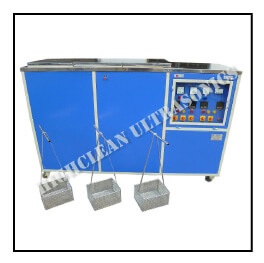HIGHCLEAN ULTRASONICS Vapour Degreasing System enhances cleaning speed and effectiveness where high degree of cleaning is required. These systems save energy, labour, floor space, consumables and hence most cost effective.
How does it work?The components are first cleaned in precleaning chamber for removal of gross contaminates, followed by vigorous ultrasonic agitation. Then the components are held in vapour chamber for vapour condensation to remove the residual contamination.
As the components reach the vapour temperature the condensation stops and components come out clean and dry. For efficient solvent recovery, water is circulated in the condensing coils. The system comprises of two, three or four chambers depending upon the level of contamination and degree of cleaning required. Units are also available with direct refrigeration cooling systems, distillation plants, filtration plants and fume extraction systems.


Vapor degreasers are industrial cleaning systems that use the vaporization and condensation of a solvent to clean and degrease parts and components. These systems can be configured with either single chamber or multi-chamber designs, depending on the specific cleaning requirements and workflow.
Single Chamber Vapor Degreasers:
- Single chamber vapor degreasers have a single chamber or tank where the cleaning process takes place.
- The chamber is typically divided into two sections: the boiling sump and the vapor/condensing zone.
- The boiling sump contains the solvent, which is heated to its boiling point, creating a vapor above the liquid.
- The parts to be cleaned are placed in a basket or rack and immersed in the boiling solvent, where the vapor condenses on the surfaces of the parts.
- As the vapor condenses, it dissolves and flushes away contaminants and oils from the parts, leaving them clean.
- The vapor-degreased parts are then removed from the chamber and typically go through a drying process to remove any remaining solvent.
Multi-Chamber Vapor Degreasers:
- Multi-chamber vapor degreasers consist of multiple interconnected chambers or zones to perform various cleaning steps.
- The chambers are typically designed for sequential operations like pre-cleaning, vapor degreasing, and drying.
- Pre-cleaning chamber: In this chamber, the parts undergo initial cleaning using solvents or other cleaning agents to remove heavy or bulk contaminants.
- Vapor degreasing chamber: The parts are then transferred to the vapor degreasing chamber, where the solvent vapor condenses on the surfaces, dissolving and removing any remaining contaminants.
- Rinse chamber (optional): Some multi-chamber systems may include a rinse chamber where the parts are rinsed with a clean solvent or a rinse agent to remove any residual solvent or cleaning agent.
- Drying chamber: After the cleaning process, the parts are moved to a separate drying chamber, where heat, vacuum, or other methods are used to remove any remaining traces of solvent and ensure complete drying.
Multi-chamber vapor degreasers allow for more complex cleaning processes and can accommodate larger volumes or different types of parts simultaneously. They provide flexibility in tailoring the cleaning process to specific requirements, such as pre-cleaning, precision cleaning, rinsing, and drying.
Both single chamber and multi-chamber vapor degreasers utilize the same basic principles of vaporization and condensation to clean and degrease parts. The choice between single chamber and multi-chamber configurations depends on factors such as the type and volume of parts, required cleaning steps, throughput, and specific cleaning objectives.
